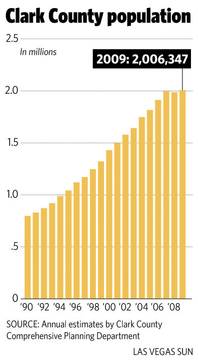Saturday, Nov. 14, 2009 | 2 a.m.

Sun Archives
- Census Bureau releases data on U.S., Clark County (10-27-2009)
- North Las Vegas among nation’s fastest-growing cities (7-10-2009)
- Demographic changes in Clark County (5-26-2009)
- Nevada falls to No. 8 in population growth (12-22-2008)
- Vacant homes, fewer people. This is Vegas? (11-15-2008)
- County ahead of population curve (8-21-2008)
- Measuring population in moving boxes (8-4-2008)
Last year’s headlines about our population crystallized the bad news swirling about Clark County: 10,000 fewer people were living here on July 1, 2008, compared with a year earlier. So much for the region’s remarkable year-after-year growth.
Not only had it gone kaput, but those numbers, based on how the county estimated its population at the time, said we were now going in reverse.
Blame it, of course, on the recession, with the collapse of the job market and the wholesale dislocation of families to home foreclosures. It made sense that few people were moving here and a lot of people were fleeing.
Now it turns out that population might not have dropped after all. In fact, despite everything about the recession, Clark County’s population has continued to grow and in fact now tops 2 million for the first time, according to the newest government estimates — ones that rely on a new formula.
Put away the mournful bagpipes, bring out the fireworks, maybe.
Either estimate — the tiny drop in population or the tiny increase — falls within the same margin of error for such calculations. But our civic mood can certainly shift depending on which number is adopted.
The figures are published by the Clark County Comprehensive Planning Department, which comes up with annual estimates to fill in the yearly blanks between Census Bureau counts.
And it’s not an exact science. For years the county relied on U.S. Postal Service input on how many homes, condos and apartments were getting mail. But concern grew that the mailman may have been overestimating occupied residences, so after July 2007, the county shifted to what it thought would be a more accurate estimator, NV Energy.
The utility can detect an occupied home on the basis of power consumption: If the customer draws enough electricity in July to operate a refrigerator and an air conditioner, the residence is considered occupied. If it draws only enough power to run a sprinkler system or security light, it is assumed to be vacant.
Using such measures from utility companies is a common practice across the country in helping to determine local populations, says Jon Wardlaw, an assistant county planning manager.
The utility’s estimate, used for the July 1, 2008 count, showed 10,000 fewer residents than what the Postal Service estimated for the previous year. The new number should not have been interpreted as a drop in population so much as a revision of the previous year’s estimate. And this being its first involvement in estimating population, the NV Energy-assisted count may have had some minor flaws of its own.
In fact, the population gurus now think that, as NV Energy has fine-tuned its estimating process, it overcorrected from the Postal Service count and that the July 2008 figure should actually have shown an increase of 4,000 people, versus a loss of 10,000.
And this past year the county gained another 6,000 people, based on estimates using NV Energy’s input.
(Neither number takes into account births and deaths.)
With these adjustments, the county’s population is now 2,006,347.
Topping 2 million is a threshold that “people will take note of,” said Keith Schwer, director of UNLV’s Business and Economic Research Center.
Wardlaw cautions that the numbers are, indeed, estimates.
“We might have had growth or we might be neutral,” he said. “We are right inside the margin of error and when you are inside that margin, it is hard to know what’s going on with certainty ... You have got to realize the numbers we are talking about are tiny,” Wardlaw said. “We aren’t even talking 1 percent.”
One thing is for sure: The count shows that the population is no longer exploding as it had in the past two decades. The county had routinely grown by 70,000 to 90,000 people annually until 2008.
The one bit of news is the milestone count.
“It is a nice round number, but it is like the Dow hitting 10,000. Nobody gets an award for it,” Wardlaw said.
Wardlaw said he’s not surprised by some growth despite the economy’s slide. CityCenter is opening this year, and governments have added jobs.
“There is a natural outflow and inflow. It is not as scary a picture as people try to paint. A lot of people have the impression that everybody is leaving, and that is not the case.”
In this economy, any population gain is considered positive movement, considering the alternative. A decline in population results in less development and lower retail activity, and a community can go into a permanent decline, analysts say.
“Having flat population growth isn’t bad considering how many jobs we lost,” said John Restrepo, principal of Restrepo Consulting. “Usually when you lose jobs, you lose population.”
The county’s population statistics are forwarded to Jeff Hardcastle, Nevada’s demographer, who will combine the numbers with his calculations and release the state estimate next year. Population numbers help determine distribution of tax revenue. In his calculations, Hardcastle uses housing estimates, but factors in the workforce, employment and school enrollment.
Among cities, the county estimates Las Vegas grew from 599,087 to 607,876; North Las Vegas grew from 216,672 to 221,003; and Henderson grew from 272,063 to 275,134.
Outside the valley, Boulder City’s population fell from 16,840 to 16,511. Mesquite grew from 19,939 to 21,253.
And don’t forget: the population estimates are subject to error, and the region won’t have a better handle on growth until the U.S. Census Bureau issues its data in December 2010.
So it’s still possible we did lose population. But let’s stay positive.
A version of this story appears in this week’s In Business Las Vegas, a sister publication of the Sun.


Join the Discussion:
Check this out for a full explanation of our conversion to the LiveFyre commenting system and instructions on how to sign up for an account.
Full comments policy